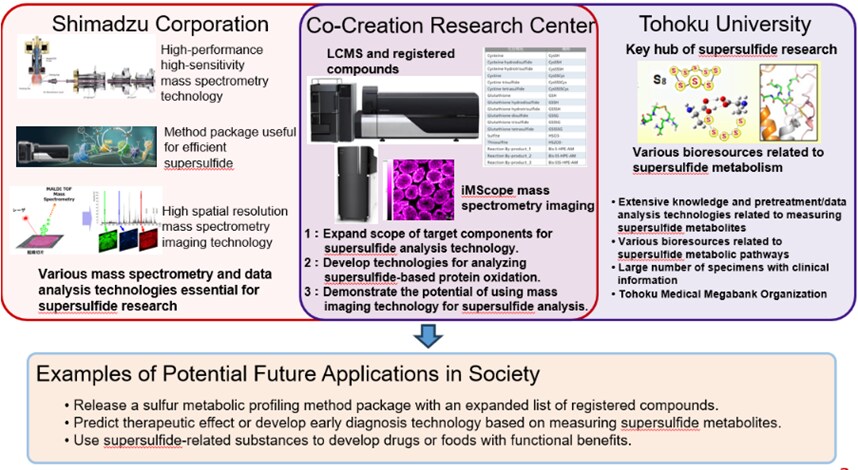Contributing to the Development of Anti-Aging Drugs and Foods by Identifying Properties of Supersulfides with High Antioxidative Properties
Establishment of Shimadzu × Tohoku University Supersulfides Life Science Co-Creation Research Center
Shimadzu Corporation (hereinafter “Shimadzu,” located in Kyoto City, Kyoto Prefecture, and led by President & CEO Yasunori Yamamoto) and Tohoku University (located in Sendai, Miyagi Prefecture, and led by President Hideo Ohno) opened the Shimadzu × Tohoku University Supersulfides Life Science Co-Creation Research Center of (hereinafter “Co-Creation Research Center”*1). The two parties will engage in joint research at the Co-Creation Research Center for 3 years, starting from April 2024. By identifying the properties of supersulfides involved in the aging mechanism of biological organisms, the collaboration is intended to contribute toward establishing diagnostic and treatment methods for a variety of diseases and developing foods with functional benefits that help improve health.
Supersulfide is the generic term for substances with sulfur bound to an organic compound, such as amino acids present in blood or body organs. Due to their powerful antioxidant properties, they are thought to help control the function of reactive oxygen. Excessive reactive oxygen levels are considered to be a factor for causing fatigue, aging, or diseases. Identifying the metabolic metabolisms of supersulfides is expected to be useful for establishing new diagnostic, preventive, or treatment methods or for developing food products with functional benefits. Professor Takaaki Akaike of Tohoku University (Department of Environmental Medicine and Molecular Toxicology, Graduate School of Medicine) is a pioneer in supersulfide research. In 2017, he was the first person in the world to discover that biological organisms metabolize energy by means of supersulfides. Shimadzu Corporation has been collaborating in joint research with the Akaike Laboratory since 2020. In 2021, that collaboration developed LC/MS/MS method package software for reactive sulfur profiling based on measuring supersulfides in biological organisms using a Shimadzu liquid chromatograph mass spectrometer (LC-MS) system.
At the newly established Co-Creation Research Center, researchers will engage in developing new techniques for simultaneously analyzing a greater variety of supersulfides, observing the distribution of supersulfides within organs using a Shimadzu iMScope imaging mass microscope*2, and so on. The plan is for the Co-Creation Research Center to be established and the joint research agreement to be effective for 3 years, starting from April 2024. Shimadzu and Tohoku University intend to contribute toward achieving longer and healthier lives through advancements in technologies for analyzing supersulfides.

Overview of Co-Creation Research Center
- Name
Shimadzu × Tohoku University Supersulfides Life Science Co-Creation Research Center - Description of Activities
Establish technologies for analyzing supersulfides based on the supersulfide life science field proposed as a new academic research field by Tohoku University. Propose searching for and planning research topics related to other analytical technologies.
① Accelerate researching and developing technologies related to supersulfide analysis.
② Identify, plan, and propose research topics related to establishing new diagnostic/treatment methods or developing foods and other items intended for improving health. - Operating Organization
(1) Person with overall responsibility for operations
Ryo Yamaguchi (Instruments Expert Group, Solutions Center of Excellence, Analytical & Measuring Instruments Division, Shimadzu Corporation), Specially-Appointed Professor, Graduate School of Medicine, Tohoku University(2) Person responsible for supporting operations
Professor Takaaki Akaike, Graduate School of Medicine, Tohoku University(3) Participating Faculty
Professor Hozumi Motohashi, Graduate School of Medicine, Tohoku University
Minkyung Jung, academic researcher, Graduate School of Medicine, Tohoku University
Jun Yoshitake, academic researcher, Graduate School of Medicine, Tohoku University - Location
Medical Research Building, Graduate School of Medicine - Collaboration Period
April 1, 2024 to March 31, 2027
- Terminology
- *1: A collaboration scheme to develop a collaboration base for planning and implementing co-creation programs, such as joint research and human resource development, to further promote and develop industry-academia co-creation.
Website of Tohoku University Head Office of Enterprise Partnerships (Co-Creation Research Center) - *2: Mass spectrometer equipped with both a mass microscope probe and optical microscope. It provides visual imaging of image information acquired with the microscope and component distribution information acquired with the mass spectrometer. That enables the simultaneous acquisition of both spatial information and chemical information, which was not possible with conventional analytical instruments.


